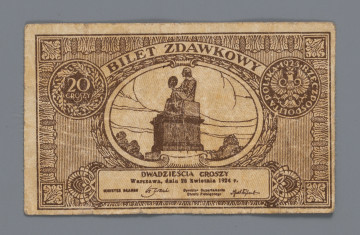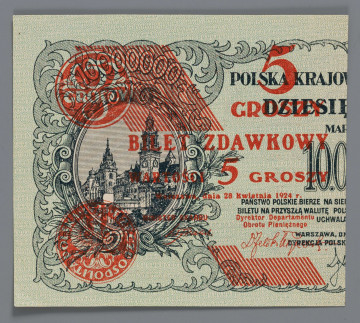
10 groshes [Polish: grosze]
1924
National Museum in Lublin
Part of the collection: Paper money during the Second Polish Republic
The appearance of substitute money in circulation was usually associated with a period of economic difficulties caused by war or serious economic problems. However, in some cases, the substitute money, apart from the negative phenomena mentioned, was also a harbinger of change for the better. Such was the case in the spring of 1924, when, as part of improving the country's economic situation, Władysław Grabski's Government decided to introduce perfunctory tickets. Their purpose was to temporarily satisfy market needs related to small transactions. At the same time, this was an element of the far-reaching fiscal reform. In the government's general conception, the role of petty cash was to be played – as in other countries – by metal coins. This was due to metal’s durability, which was indispensable in the case of the low denominations that were much more frequently used in everyday transactions, and thus wore out more quickly. The late establishment of the State Mint and its launch of coin production forced Grabski's Government to resort to a substitute measure, in the form of pass tickets. The tickets had the same denominations as the coins they replaced. Consequently, among the penny tickets, the highest denomination was represented by the 50-grosz coin. Its graphic design was quite modest and similar to that of ten- and twenty-grosz tickets. On the obverse, the central field depicted the equestrian statue of Józef Poniatowski, and lower on the sides the obverse and the reverse of the fifty-grosz coin, which the ticket replaced. Everything was placed on the background of an ornamental plait with floral motifs. The whole was completed with the date of issue and signatures of Władysław Grabski, Minister of Treasury, and Feliks Młynarski, Director of the Monetary Circulation Department. On the reverse, there was only the text of a legal clause guaranteeing full convertibility and setting the start and end dates of the exchange of tickets as 1 November 1924 and 31 January 1925, respectively.
The interval between the date of issue of fifty-grosz tickets (28 April 1924) and introduction into circulation (8 May 1924) was not large. In the case of the coins they replaced, it was slightly worse. The year 1923 was stamped on them as the date of issue, but they started to circulate on 1 July 1924.
Leszek Poniewozik
Author / creator
Dimensions
cały obiekt: height: 84 mm, width: 52 mm
Object type
paper money
Technique
Material
paper
Creation time / dating
Creation / finding place
Owner
The National Museum in Lublin
Identification number
Location / status

1924
National Museum in Lublin

1924
National Museum in Lublin

1924
National Museum in Lublin
DISCOVER this TOPIC
Castle Museum in Łańcut
DISCOVER this PATH
Educational path